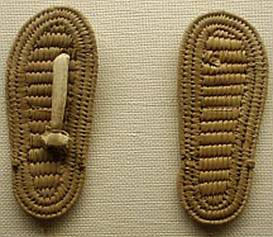DAILY LIFE
|
Crops included wheat for bread and barley for beer. Sheep and goats provided food and fleece for woolen cloth. From the flax plant, weavers obtained the fibers for linen, which was used for clothing and bedding. The well-to-do washed and used scented oils. Their garments included kilts for men and beautifully pleated sheer linen gowns for women. Others wore linen tunics, but workers of the lower class generally wore nothing. Due to the hot climate, many shaved their heads and the wealthy wore wigs.
|
|
|
Although most went barefoot, there were sandals made of palm fiber or braided papyrus, like the ones pictured here. The pharaoh had sandals with images of his enemies on the soles so he could tread upon them all day.
|
|
|
Egyptian jewelry was gorgeous and copies are still being reproduced by various sources including museum gift shops. The earrings pictured left are from the tomb of King Tutankhamun. Make-up for upper-class men and women alike was common, especially the use of a dark eyeliner (made of kohl) that had the practical use of deflecting glare from the bright desert sun. (See Ramses II above). Overall, the affluent had a sophisticated and elegant lifestyle. (Image courtesy of SlidePresentationPublishers.com) |


